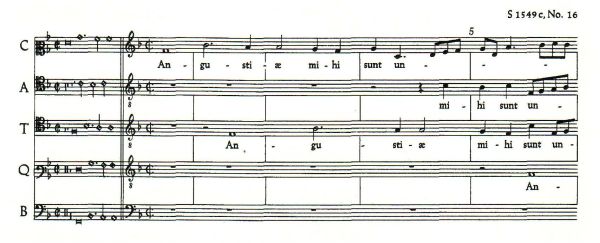| Version imprimante |
La musique de Cipriano De Rore
Angustiae mihi sunt undique - Deas aeterne
A. Type:
Motet
B. Nombre de voix:
5vv
Ct. Texte:
: Lire
E. Se trouve dans les sources de partitions suivantes:
suivant: _Onderzoek van de bron (internet) door Arnold Loose en/of Wim Daeleman (2016) :
-
1550 (ca.) :
BSB Mus.ms. 16 (ca.1550)
: 'BSB Mus.ms. 16 (ca.1550)'
suivant: Bernstein, Jane A. (1998) :
-
1549 :
{Bernstein} - 88
: 'Primo libro de motetti a cinque voci'
suivant: CMME Project(The) - Dumitrescu (e.a.), Theodor :
-
{Census} - ParisBNC 851 ("Bourdeney Manuscript")
: '{Census} - ParisBNC 851 ("Bourdeney Manuscript")'
suivant: Lewis, Mary S. (1988) :
-
1549 :
{Lewis_1} - 134
: 'RORE. MOTETTI A 5 LIB. III°'
suivant: Meier, Bernardus (1959) :
-
1549 :
{RISM} - 1549_08
: 'Il terzo libro di Motetti a cinque voci di Cipriano de Rore, et de altri eccellentissimi musici, novamente ristampato, con una buona gionta de motetti novi.'
suivant: Owens, Jessie Ann (2001) :
-
1549 :
{RISM} - 1549_07
: 'Primo libro di motetti a cinque voci da diversi eccellentissimi music composti et non stampati, novamente posti in luce, et con somma diligentia coretti. Come a' cantanti sarà manifesto.'
F. Partition moderne:
See 'Meier, Bernardus : Cipriani Rore Opera Omnia, Vol I : Motets' : p.147
I. Incipit:
 Source:
'Meier, Bernardus : Cipriani Rore Opera Omnia', American Institute of Musicology
Source:
'Meier, Bernardus : Cipriani Rore Opera Omnia', American Institute of Musicology
L. Références:
Références avec citation/commentaire:
1 : Meier, Bernardus,
Cipriani Rore Opera Omnia, Vol I : Motets
(American Institute of Musicology (AIM), 1959)
- p.V
: 'The fact that commixtio is an unusual feature is stressed in bars 53-59 of Angustiae mihi sunt undique, where it is applied at the words qui absconditorum es cognitor in the melody of Tenor, Bassus, Quintus and Altus. AIthough by no means obvious here, the fifth la-re (d-G or d'-g) does replace the prevailing species sol-ut (c-f), while cadences on g are continually avoided.'
2 : Meier, Bernardus,
Cipriani Rore Opera Omnia, Vol I : Motets
(American Institute of Musicology (AIM), 1959)
- p.V
: 'It is also noteworthy that in some cases dissonances (suspensions of 6 5 or 6/4 5/3 , related in each case to the really lowest voice) are used in the sense of affective symbolism, as for example in Angustiae mihi sunt undique (bars 61-64: falsum testimonium, and 81f.: malitiose), Domine quis habitabit (bars 49-51: malum), In die tribulationis meae (bars 36f., 38f.: prae ladirimis), Levavi oculos meos (bars 94f.: ab omni malo), Quanti mercenarii (bars 20-27: Ego autem hic fame pereo) and Tribularer, si nescirem (bars 73f.: dolorum meorum). With this use of dissonances Rore apparently follows the steps of his teacher Willaert, whose motets too contain passages of this kind, when the text suggests such a procedure.'
3 : Meier, Bernardus,
Cipriani Rore Opera Omnia, Vol I : Motets
(American Institute of Musicology (AIM), 1959)
- p.IV
: 'In bars 68-72 of Angustiae mihi sunt undique, at the words et ecce morior, we find at one and the same time the use of fauxbourdon texture, low register and the semitone, d’-e flat', which is foreign to the mode.'
4 : Meier, Bernardus,
Cipriani Rore Opera Omnia, Vol I : Motets
(American Institute of Musicology (AIM), 1959)
- p.IV
: 'In a similar way we find katabasis in the words in morte (Usquequo Domine, Cantus, bars 8 5 f.), or on mors mihi est (Angustiae mihi sunt undique, bars 29-33). In this last case it is used with long measures and Fauxbourdon texture. '
Page (re)travaillée la dernière fois :
25/10/2023 21:11:51
Mon code :
#6270 (M_1_147)